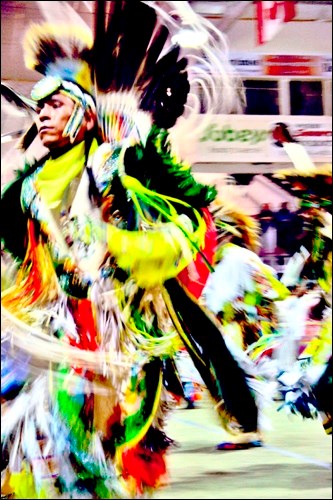The Annual Sakicawasihk powwow was held last week at the North Battleford Civic Centre.
I had the opportunity to attend this cultural marvel and, I have to say, it was a lot to absorb considering I had never experienced anything like it before.
I recruited a cousin to come with me to the social event; she's been going to powwows since she was six years old. She lived, for a short time, on the Waterhen First Nation reserve and experienced these at least once or twice a year.
She was surprised when I told her that I had never been to a powwow before, and was a good sport about tagging along with me.
When we arrived we were welcomed into the arena by the sound of drums that resonated throughout the entire building. In the background I could hear voices in song. I looked around to see where it was coming from but I was quickly distracted by a group of colorful young woman and children.
They were dressed from head to toe in beautiful, ornate costumes. Their hair was perfectly braided and decorated with intricate beaded barrettes and hair ties with long fur ends. Their beauty was highlighted with scarlet red lipstick and they had rosy blushed cheeks. They wore an abundance of stunning jewellery, each piece remarkably unique from the next dancer. One of the young girls explained to me her jewellery is a combined collection from all of the past powwows she's danced in. Her costume was carefully assembled and sewn as a gift to her from her mom and aunt.
The boys and men were equally as striking. Their attire seemed to be more on the bright side, presenting more brilliancy in colour than attention to detail like the women. Their outfits were composed of a wealth of feathers often accompanied by a headdress, each one larger and more impressive, some of them nearly touching the floor. Some wore elaborate beaded vests with images of eagles, feathers and flowers. The sound of cones and bells followed them wherever they went.
Suddenly everyone rushed down the stands to see the tiny tots perform, aged newborn to six. It was almost irresistible not to follow; I couldn't wait to see these little ones looking like miniature replicas of their parents and grandparents. My heightened curiosity was a result of my husband's aunt, who spoke fondly of past powwows that she attended where the little children dancing nearly brought her to tears.
The youngsters scurried from all directions onto the grounds to take their place, some unable to contain their excitement before the music started.
One small child, maybe two years of age, gracefully walked out with her hands firmly on her hips, her head held high and stood in position with such confidence, waiting for her cue. As soon as the music started, she erupted in dance, letting the rhythm guide her little moccasined feet.
The child, once eager to be on the dance floor, quickly retracted when she glanced back and realized that her mother was no longer within arms reach. Then came the inevitable tears, and mom quickly rushed in to comfort the little one.
As we shuffled through the crowd we passed by a group of young men drumming. I managed to squeeze into a cluster of mesmerized spectators that formed a tight a circle around them.
I couldn't see what was going on so I reached high over the crowd, camera in hand, and took a snapshot. I wasn't sure what the excitement was all about, until I lowered my camera to see what I had captured. The energy of their chanting and drumming had the undivided attention of everyone surrounding them and the expressions on their faces in the photo translated a true sense of pride and passion.
Curious to find out more, I made my way over to the judges' table where I had the to opportunity to speak with Randall Paskemin, one of the singing judges, and he kindly explained to me the cultural significance of the powwow.
"It symbolizes life. Powwows were given to us by the Omaha people in Nebraska. It was passed on to the Soos and then it came to the plains people. It's a social dance. About thirty years ago, they started having competitions. It started out traditionally, where you would just come to dance and sing and have a good time."
As I looked around the arena, just before our departure, I saw friends and families gathered, laughing and telling jokes. Mothers braiding their daughters hair and pinning everything into place, teenaged girls giggling and putting lipstick on each other, young men shaking hands and grandmothers embracing their younger generations.
Over the years, the powwow may have adopted a more competitive nature, but the genuine significance was clear to me - dancing, singing and having a good time - remains at the heart of the powwow.
It was an enjoyable and enlightening experience for me, and it was more than I ever could have imagined. I can see why this has become such a significant part of the aboriginal culture and I'm looking forward to the next.




